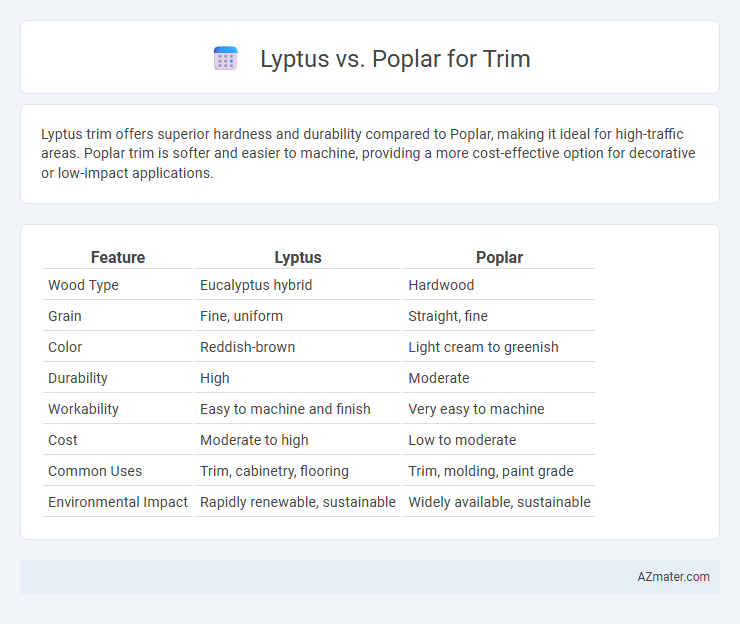Lyptus trim offers superior hardness and durability compared to Poplar, making it ideal for high-traffic areas. Poplar trim is softer and easier to machine, providing a more cost-effective option for decorative or low-impact applications.
Table of Comparison
| Feature | Lyptus | Poplar |
|---|---|---|
| Wood Type | Eucalyptus hybrid | Hardwood |
| Grain | Fine, uniform | Straight, fine |
| Color | Reddish-brown | Light cream to greenish |
| Durability | High | Moderate |
| Workability | Easy to machine and finish | Very easy to machine |
| Cost | Moderate to high | Low to moderate |
| Common Uses | Trim, cabinetry, flooring | Trim, molding, paint grade |
| Environmental Impact | Rapidly renewable, sustainable | Widely available, sustainable |
Introduction to Lyptus and Poplar for Trim
Lyptus is a fast-growing hardwood hybrid derived from Eucalyptus species, prized for its durability and smooth finish, making it ideal for trim applications requiring strength and a consistent appearance. Poplar, a softer hardwood species native to North America, offers ease of machining and a uniform grain, favored for budget-friendly trim projects with paint-ready surfaces. Both woods are sustainable choices, with Lyptus offering higher density and natural resistance to wear, while Poplar is valued for its versatility and affordability in moldings and interior trim.
Appearance and Grain Comparison
Lyptus wood features a fine, uniform grain with a smooth texture and a light reddish-brown hue that darkens with age, offering a consistent and modern aesthetic ideal for trim. Poplar exhibits a more varied grain pattern, often appearing straight but sometimes wavy, with color ranging from creamy white to light green or brown, which may require staining for a uniform finish. The tightly grained Lyptus provides a sleek, refined look, while Poplar's natural variations lend a more casual, rustic appearance to trim applications.
Hardness and Durability Differences
Lyptus wood, a hybrid eucalyptus species, exhibits a Janka hardness rating around 1,410 lbf, making it significantly harder and more resistant to dents compared to poplar, which has a Janka hardness of approximately 540 lbf. This increased hardness results in superior durability for Lyptus trim, ideal for high-traffic or impact-prone areas, while poplar, being softer and more prone to dents and scratches, suits low-traffic or painted trim applications. The superior wear resistance and density of Lyptus provide long-lasting performance, whereas poplar's softness allows easier shaping but compromises durability.
Workability and Ease of Installation
Lyptus offers excellent workability with its consistent grain and uniform density, making it easy to machine, cut, and shape for trim applications. Poplar is also highly workable due to its soft texture, allowing for smooth nailing and sanding, which reduces installation time. Both woods provide ease of installation, but Lyptus' durability and resistance to splitting give it a slight advantage for long-lasting trim projects.
Finishing and Staining Results
Lyptus, a hybrid eucalyptus wood, offers a dense, fine-grain surface that absorbs stains evenly, resulting in a smooth, rich finish ideal for high-end trim work. Poplar, characterized by its soft texture and uneven grain, tends to blotch during staining, often requiring a wood conditioner or paint-grade finish to achieve a uniform appearance. When prioritizing finishing and staining outcomes in trim applications, Lyptus provides superior consistency and a more elegant aesthetic compared to Poplar's variable results.
Cost and Availability of Lyptus vs Poplar
Lyptus, a hybrid eucalyptus, generally costs more than poplar due to its denser grain and slower production cycle. Poplar is widely available and affordable, making it a popular choice for trim in budget-conscious projects. Lyptus is less readily available, often requiring special orders, which can increase lead times and overall project expenses.
Environmental Impact and Sustainability
Lyptus wood, a hybrid eucalyptus species, is celebrated for its rapid growth and certification by the Forest Stewardship Council (FSC), making it an eco-friendly choice for trim due to sustainable plantation practices that reduce deforestation risk. Poplar, a fast-growing hardwood native to North America, also offers a low environmental footprint as it requires minimal pesticides and grows on regenerative forest lands, supporting sustainable timber harvesting. Both woods serve as renewable resources with lower carbon footprints compared to traditional hardwoods, but Lyptus's managed plantations and poplar's natural regeneration emphasize their roles in sustainable building materials.
Best Uses for Lyptus Trim
Lyptus trim is best suited for interior applications requiring durability and a smooth finish, such as window casings, baseboards, and door trims, due to its dense grain and resistance to denting. Compared to Poplar, Lyptus offers superior hardness and a more uniform texture, allowing for easier painting and staining with less blotching. Its sustainable sourcing and consistent quality make it an ideal choice for premium trim projects where long-lasting performance and aesthetic appeal are critical.
Best Uses for Poplar Trim
Poplar trim is ideal for interior applications such as window casings, baseboards, and door frames due to its smooth texture and excellent paint adhesion, making it a favorite for detailed trim work. Unlike Lyptus, which is harder and more durable, Poplar is easier to machine and shape, allowing for intricate molding profiles and fine finishes. Its affordability and versatility make Poplar trim the preferred choice for projects prioritizing aesthetic customization and budget efficiency.
Choosing the Right Wood for Your Trim
Lyptus offers a durable, dense hardwood option with a smooth finish ideal for high-end trim, while Poplar provides a softer, more affordable alternative that paints well and is easy to work with. Lyptus' tight grain and resistance to dents suit modern, long-lasting trim projects, whereas Poplar's uniform texture and lighter weight make it favorable for budget-friendly, painted trim applications. Selecting between Lyptus and Poplar hinges on balancing durability, finish quality, and cost for your specific trim needs.

Infographic: Lyptus vs Poplar for Trim
 azmater.com
azmater.com